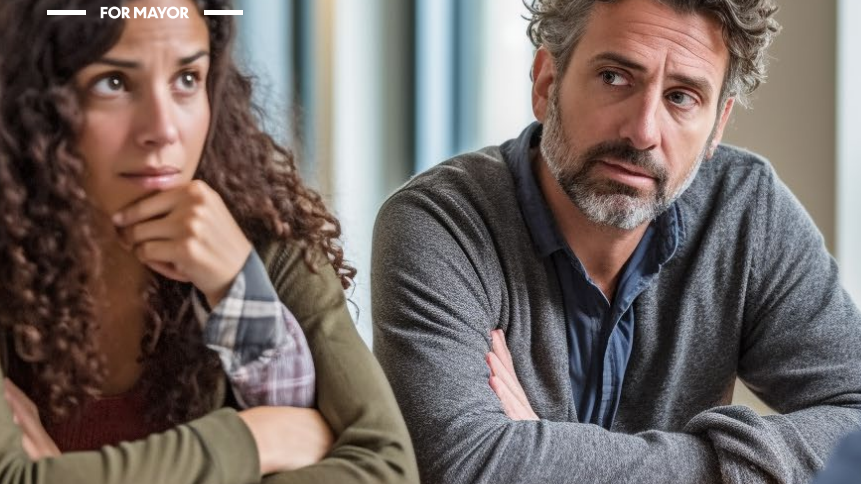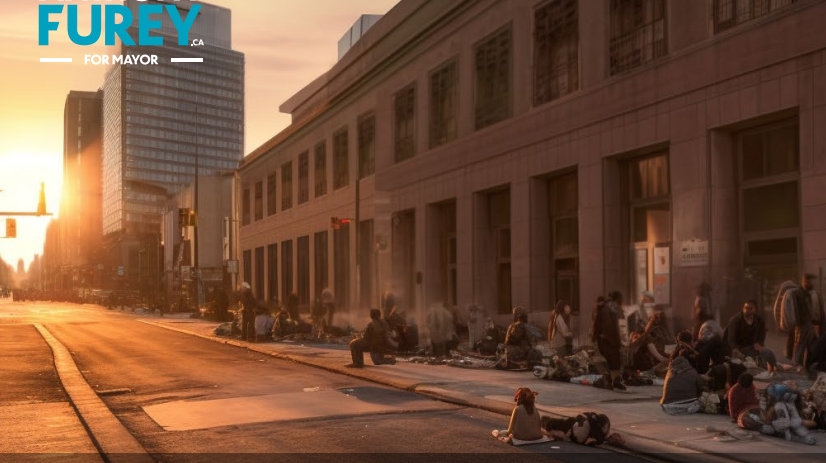Three-armed person mistakenly exposes AI-generated images in Toronto mayoral platform
A Toronto mayoral candidate’s use of AI-generated images was exposed when a photograph of a person with three arms appeared in their campaign platform.
Former newspaper columnist Anthony Furey released a 42-page platform on Monday paired with images that appeared to depict elements of Toronto – a police officer in a transit corridor and a streetcar trolleying along Queen Street, for example.
 An image in Anthony Furey's Toronto mayoral campaign platform depicts a woman with three arms (Credit: Furey platform). But then, a person with three arms unravels the visual narrative.
An image in Anthony Furey's Toronto mayoral campaign platform depicts a woman with three arms (Credit: Furey platform). But then, a person with three arms unravels the visual narrative.
“It wasn’t intentional,” Furey’s senior media advisor told CTV News Toronto, confirming the campaign used AI-generated images.
But Vass Bednar, executive director of McMaster University’s master of public policy program, said the platform does not transparently communicate or disclose the fact that the images are AI-generated, allowing voters to believe they are real.
“Instead of crediting an artist or supporting human talent, this candidate has chosen [AI],” Bednar said. “I think that gets to the crux of what is frustrating and disappointing about synthetic media.”
She lists copyright, intellectual property and bias as additional ethical concerns at play.
“What are his search terms? What is the significance of intentionally generating an image of a Black police officer? What are the demographics that seem to be represented with his underhoused or low income population?”
 A police officer in Anthony Furey's Toronto mayoral campaign platform (Credit: Furey platform). To create an AI-generated image, a user types in a prompt that outlines the focal lens they want to capture. The outcome, derived from massive datasets of real images, is a state of “hyper reality,” Paolo Granata, an associate professor of media studies at the University of Toronto, explained.
A police officer in Anthony Furey's Toronto mayoral campaign platform (Credit: Furey platform). To create an AI-generated image, a user types in a prompt that outlines the focal lens they want to capture. The outcome, derived from massive datasets of real images, is a state of “hyper reality,” Paolo Granata, an associate professor of media studies at the University of Toronto, explained.
“It’s a copy without an original,” Granata said. He scanned the “About Anthony Furey” section of his mayoral website with GPTZero to detect if his words were also automated.
The result: “Your text is likely to be written entirely by AI.”
AI-generated media can be easily used to help craft narratives that policitians are trying to convey, the professor explained. “Essentially, now AI is a tool to represent visually some kind of fears, some kind of narrative,” Granata said, pointing to two specific images.
 Anthony Furey's website bio input into GPTZero, a program that detects AI-generated words. The second image in Furey’s platform is of a sidewalk full of people wrapped in blankets surrounded by belongings, and paired with a pitch to phase out drug injection sites in Toronto. The third image is of more than two dozen tents pitched in a park nearby high-rise office buildings, alongside his action plan to “reclaim Toronto parks” by removing “drug and violence-ridden tent encampments, step up police.”
Anthony Furey's website bio input into GPTZero, a program that detects AI-generated words. The second image in Furey’s platform is of a sidewalk full of people wrapped in blankets surrounded by belongings, and paired with a pitch to phase out drug injection sites in Toronto. The third image is of more than two dozen tents pitched in a park nearby high-rise office buildings, alongside his action plan to “reclaim Toronto parks” by removing “drug and violence-ridden tent encampments, step up police.”
 People appear to sit on a street in Anthony Furey's mayoral campaign platform (Credit: Furey platform).
Safe injection sites and encampments are present in real images of Toronto, but AI presents an opportunity to tweak elements – increasing the number of tents and people living on the streets – to appear and communicate the urgency of Furey’s pitch to “make Toronto safe again,” as his platform states.
People appear to sit on a street in Anthony Furey's mayoral campaign platform (Credit: Furey platform).
Safe injection sites and encampments are present in real images of Toronto, but AI presents an opportunity to tweak elements – increasing the number of tents and people living on the streets – to appear and communicate the urgency of Furey’s pitch to “make Toronto safe again,” as his platform states.
 Tents in a park are seen in Anthony Furey's Toronto mayoral campaign platform (Credit: Furey platform). “When a politician is able to set the context … everything will make sense, people will believe the context because you set the framing,” Granata said.
Tents in a park are seen in Anthony Furey's Toronto mayoral campaign platform (Credit: Furey platform). “When a politician is able to set the context … everything will make sense, people will believe the context because you set the framing,” Granata said.
“I think what we are seeing now in this political campaign in Toronto, we are witnessing the beginning of a massive phenomenon that will affect political campaigns in the future.”
CTVNews.ca Top Stories

Trudeau to announce temporary GST relief on select items heading into holidays
Prime Minister Justin Trudeau will announce a two-month GST relief on select items heading into holidays to address affordability issues, sources confirm to CTV News.
'Ding-dong-ditch' prank leads to kidnapping, assault charges for Que. couple
A Saint-Sauveur couple was back in court on Wednesday, accused of attacking a teenager over a prank.
Border agency detained dozens of 'forced labour' cargo shipments. Now it's being sued
Canada's border agency says it has detained about 50 shipments of cargo over suspicions they were products of forced labour under rules introduced in 2020 — but only one was eventually determined to be in breach of the ban.
'It changed my life': Montreal-area woman learning how to walk after being hit by stray bullet
A 24-year-old woman is learning how to walk again after being shot while lying in her bed in Repentigny, Que.
DEVELOPING International Criminal Court issues arrest warrants for Netanyahu and Hamas officials
The International Criminal Court issued arrest warrants on Thursday for Israeli Prime Minister Benjamin Netanyahu, his former defense minister and Hamas officials, accusing them of war crimes and crimes against humanity over the war in Gaza and the October 2023 attacks that triggered Israel’s offensive in the Palestinian territory.
Genetic evidence backs up COVID-19 origin theory that pandemic started in seafood market
A group of researchers say they have more evidence to suggest the COVID-19 pandemic started in a Chinese seafood market where it spread from infected animals to humans. The evidence is laid out in a recent study published in Cell, a scientific journal, nearly five years after the first known COVID-19 outbreak.
REVIEW 'Gladiator II' review: Come see a man fight a monkey; stay for Denzel's devious villain
CTV film critic Richard Crouse says the follow-up to Best Picture Oscar winner 'Gladiator' is long on spectacle, but short on soul.
Donald Trump picks former U.S. congressman Pete Hoekstra as ambassador to Canada
U.S. president-elect Donald Trump has nominated former diplomat and U.S. congressman Pete Hoekstra to be the American ambassador to Canada.
Alabama to use nitrogen gas to execute man for 1994 slaying of hitchhiker
An Alabama prisoner convicted of the 1994 murder of a female hitchhiker is slated Thursday to become the third person executed by nitrogen gas.
































